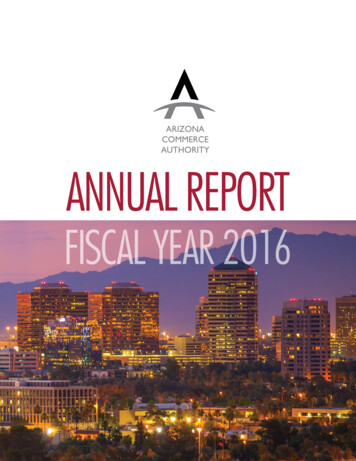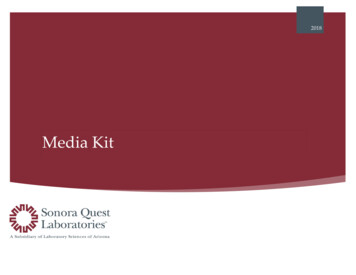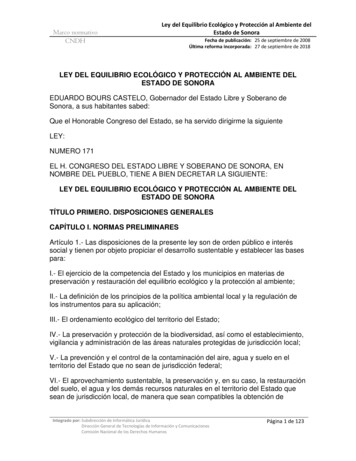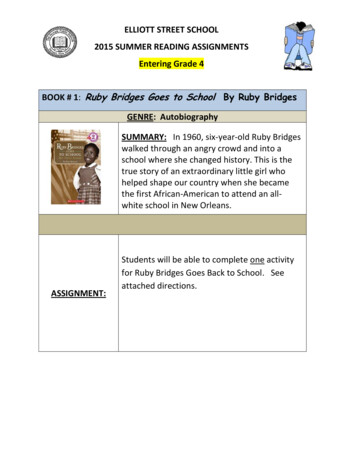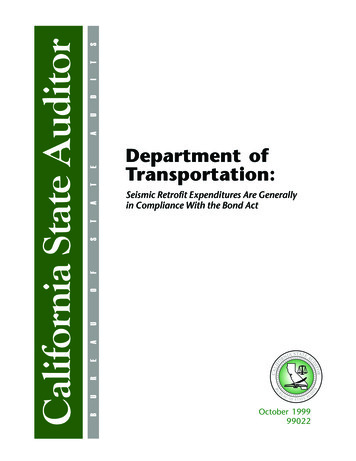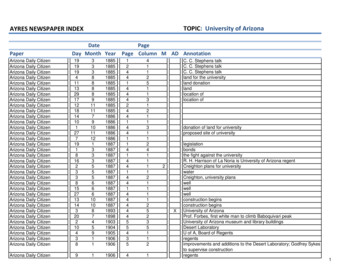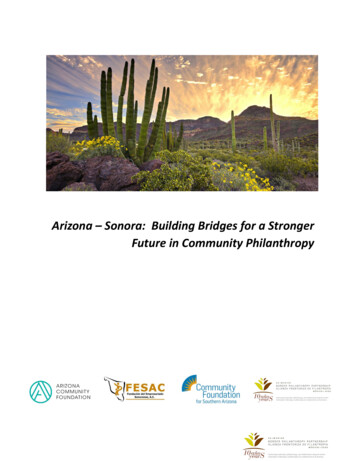
Transcription
Arizona – Sonora: Building Bridges for a StrongerFuture in Community Philanthropy
Table of ContentsManaging Partners Missions .3Acknowledgements .3Introduc on .4General findings .7Nonprofits.7Corpora ons .92005 – 2020 Corporate Giving Trend Comparison.11About the Surveys .13Conclusions and Next Steps.14Appendix A – Regional Survey Instruments .17Nonprofit Survey .17Corporate Survey .20Arizona – Sonora: Building Bridges for a Stronger Future in Community Philanthropy1
Arizona – Sonora: Building Bridges for a Stronger Future in Community Philanthropy2
Managing Partners MissionsLead, serve and collaborate to mobilizeenduring philanthropy for a beYer Arizona.Generate social wellbeing by suppor ng andaccompanying civil society organiza ons in thepursuit of sustainable community development.Create a stronger community by connec ngdonors to causes they care about now andforever.Support a network of organiza ons that buildprosperity through leadership, collabora on, andphilanthropy in the U.S.-Mexico Border regionincluding the 10 Border States.AcknowledgementsThis report was made possible by funding from the Building Broader Communi es in the Americas(BBCA) ini a ve, a collabora on of community founda ons and partner organiza ons working togetherto build stronger, smarter and more resilient communi es throughout the Americas by enhancing theeffec veness of community founda ons’ responsiveness to them. This ini a ve is led by CFLeads inpartnership with the Inter-American Founda on and the Charles Stewart MoY Founda on.We thank our partners for their valuable support in distribu ng the surveys:Arizona – Sonora: Building Bridges for a Stronger Future in Community Philanthropy3
IntroductionThe Arizona Community Founda on (ACF), the Community Founda on for Southern Arizona (CFSAZ),and Fundación del Empresariado Sonorense, A.C. (FESAC) joined forces to support the Arizona – Sonora:Building Bridges for a Stronger Future in Community Philanthropy mapping project to strengthenphilanthropic giving in both states. The U.S.-Mexico Border Philanthropy Partnership was selected tomanage the study.The study was funded by a grant from CF Leads as part of the Building Broader Communi es in theAmericas Ini a ve, which was designed to promote increased transna onal charitable giving in theAmericas via U.S. and Mexican community founda ons and is funded by the Inter-American Founda onand the Charles Stewart MoY Founda on. Moreover, addi onal funding was provided by ACF, CFSA andFESAC, in form of financial and in-kind support in furtherance of this study.We wish to express our apprecia on to the members and leaders of our academic, nonprofit andphilanthropic partners including Arizona State University Lodestar Center for Philanthropy and NonprofitInnova on, Chicanos por la Causa, and Fundación Tichi Muñoz for their support to secure par cipa onin the survey. Their efforts to distribute the surveys and to engage their members was invaluable to thisprocess.This report examines corporate charitable giving in the Arizona – Sonora region. The report highlights theculture of giving in our region, issues and causes important to donors, trends and giving paYerns,nonprofit percep ons of corporate giving, barriers to corporate giving, and opportuni es for communityfounda ons to take a leadership role in galvanizing more charitable giving in the region. The partnerorganiza ons believe that a connected border region is stronger and more prosperous when we ac vatestakeholders from across the nonprofit, business, and government sectors to create a healthier, moreprosperous border region by increasing local corporate social responsibility.The original research plan sought to inform Community Founda ons on the philanthropic interests oflocal community members giving locally and trans-na onally We also sought to beYer understandcompliance issues related to the U.S. Patriot Act requirements and Mexico’s Ley de An -lavado.However, our research team determined we needed to first determine giving habits of corpora onssuppor ng the nonprofit sector in both Arizona and Sonora, as well as study the nonprofit rela onshipwith the corporate sector. The partner organiza ons determined it was necessary to distribute a revisedsurvey tool that would update a 2005 study of Corporate giving in the U.S.-Mexico Borderlands. FESACcollaborated with El Paso Community Founda on, Interna onal Community Founda on, FundaciónInternacional de la Comunidad, U.S.-Mexico Border Philanthropy Partnership, and the Synergos Ins tute.The new survey tool was adapted and mirrored the tool disseminated in a similar mapping project beingcarried out in the San Diego-Tijuana region.This report is important to facilitate a beYer understanding of the rela onship between our corporateand nonprofit communi es, and how these two sectors may work together to resolve issues andchallenges facing our Arizona – Sonora region bina onal region. It begins to tell a narra ve about whatcorpora ons and nonprofit organiza ons understand about each other, and how we may work beYertogether for the Arizona – Sonora bina onal community.Arizona – Sonora: Building Bridges for a Stronger Future in Community Philanthropy4
The Arizona-Sonora rela onship is unique in many aspects. The two states are inextricably linked.Arizona and Sonora share a long history of community engagement. The two states share a 300-mileland border and have six land ports of entry between them. The popula ons total over 10 millionpeople – 7,286,00 in Arizona and 3,050,473 in Sonora. Poli cally, the top State Government electedofficials interact with their counterparts daily. Despite poli cal party affilia on, elected officials fromboth sides of the border coordinate and support ac ons for public policy advancement for the mutualbenefit of Arizona and Sonora. This phenomenon has been going on for decades. Officials are expectedto coordinate with their neighbor. While collabora on exists all along the border, only in Arizona andSonora is this prac ce embedded in the daily life of elected officials from both States.The Arizona-Sonora region is challenged on many fronts. During the last 15 years, our region has beenhome to extreme acts of violence due to trafficking of arms, drugs, and people. Migrant caravanscon nue to move northward from Central America and Southern Mexico in search of new economicbeginnings for themselves and their families. Changes to the U.S. Government immigra on laws andpolicies are making it more difficult for individuals to cross into the United States, and as a result areforcing more migrants to remain in Nogales. And most recently, the COVID-19 health pandemic hascreated a healthcare disaster for an overwhelmed healthcare system in a developing country causingsignificant contagion and death for thousands of people. These challenges highlight the need for thestudy on cross-border giving to help civil society leaders understand the need for a strong nonprofitsector in our bina onal region with sufficient human and financial resources to meet the needs of ourcommunity as a civil society deserves.The Nonprofit and Philanthropic Sector in the RegionThere is clearly strong interest to support philanthropy in both Arizona and Sonora. The partnerorganiza ons’ efforts since 2005 have fostered significant investment and growth in the sector.Nonprofit organiza ons today are seemingly more sophis cated in securing financial support for theircauses, and the presence of community and family founda ons in the region is helping to sustain thesector. This is seen with the strong financial support from Arizona Community Founda on, CommunityFounda on for Southern Arizona, Fundación del Empresariado Sonorense, and Fundación Tichi Muñoz,as well as through the capacity building efforts of the ASU Lodestar Center on Philanthropy andNonprofit Innova on, U.S.-Mexico Border Philanthropy Partnership, and the Centro de Formación Social.According to the Arizona Community Founda on report “Arizona Nonprofits: Economic Power, Posi veImpact”, shows that Arizona’s nonprofit sector is comprised of 21,000 organiza ons and is “a thrivingnetwork of social-purpose corpora ons and a powerful economic driver in our state which employsthousands of people and contributes significantly to the Gross State Product”. Mexico lacks a singledata base of all nonprofit organiza ons registered before the different agencies of the federalgovernment. Sources indicate that the total amount of nonprofit organiza ons in the state of Sonora isThe Federal Registry of Nonprofit Organiza ons1 includes 812 nonprofits in Sonora, showing that nearly50% (398 nonprofits) were ac ve in 2020. The Mexican Center on Philanthropy (CEMEFI, for its name in1 The Registry was created under the Federal Law for the Promo on of Civil Society Organiza ons in Mexico butregistra on is not required by law. Therefore, donatarias autorizadas may not be registered in this database. Thismeans that a legally incorporated nonprofit organiza on can be listed in one database, both or none.Arizona – Sonora: Building Bridges for a Stronger Future in Community Philanthropy5
Spanish) reports the total number of nonprofits in Sonora at 862 for 20202. The total number ofdonataria autorizadas in Mexico is 9,0803 and 316 grantmaking founda ons.The size and scope of the sector showcases the opportunity to grow addi onal support for increasedcharitable giving between our communi es. Our partner organiza ons collaborate on a regular basis tosupport giving between Arizona and Sonora. There is significant opportunity educate donors about theneeds and opportuni es to be excellent corporate socially responsible ci zens.The findings in this report demonstrate the incredible generosity of corporate philanthropy and theheroic work of the nonprofit sector in both Arizona and Sonora. By beYer understanding the needs andopportuni es, we can make an even larger social impact for an improved quality of life for both Arizonaand on-3er-sector3Centro Mexicano para la Filantropía, May 2020Arizona – Sonora: Building Bridges for a Stronger Future in Community Philanthropy6
General findingsNonprofits Data results demonstrate that a liYle more than 90% of nonprofits surveyed in the Arizona – Sonoraregion are registered in just one country, either the United States or Mexico. Nearly twice as manynonprofits in Sonora are registered in both countries compared to those surveyed in Arizona. The data report's findings show that nonprofits in the Arizona – Sonora region work primarily in thecountry in which they are registered. However, nonprofits in Arizona tend to work more in bothcountries in comparison to those in Sonora. This finding has important implica ons for developingand strengthening bina onal collabora on among nonprofits in the Arizona – Sonora region. When comparing the number of years’ nonprofits were established, significant differences werefound between Arizona and Sonora. While 80% of nonprofits in Arizona were established more than15 years ago, 64.62% of nonprofits in Sonora were established less than 15 years ago. This findingindicates a great contrast in the level of experience and sector maturity between nonprofits in thebina onal region. Nearly 40% of nonprofits in Arizona stated having an organiza onal budget of less than US 100,000.However, 80% of nonprofits in Sonora have a budget of 100,000 or less. This finding indicates thatnonprofits in both states are doing extraordinary work despite limited budgets. The study found that at a regional average, more than 50% of nonprofits in the Arizona – Sonoraregion did raise enough money to cover their opera ons in the past fiscal year. The top threefunding sources for nonprofits in the Arizona – Sonora region are individual donors, corpora onsbusiness and founda ons. It is interes ng that nearly 30% of surveyed nonprofits in the Arizona –Sonora region do not receive government funding. However, the data also indicates that 50% ofnonprofits in Sonora did not, in comparison to nearly 30% of those in Arizona. For those nonprofitsthat did not raise enough money, the average gap was of less than 25% for both nonprofits inArizona and Sonora. Nearly 100% of funding is primarily from the country in which the nonprofit is registered. Merely25% are receiving funding from the border region, the other 75% obtain funding elsewhere. The results obtained highlight that 22% of the nonprofits in Sonora and only 9% in Arizona solicitfunds from a business/corpora on located on the other side of the border. The top three corporate philanthropy strategies used to secure dona ons from businesses /corpora ons by nonprofits in the Arizona – Sonora region are grant requests, in – kind dona ons andsponsorships.Arizona – Sonora: Building Bridges for a Stronger Future in Community Philanthropy7
Other strategies used less oqen are:26.59%24.58%23.54%Talent or service dona8onsMatching gi sCorporate volunteers12.70%12.70%Payroll deduc8onsInternal employee fundraising24.34%OtherPercentages do not add to 100 since nonprofits could select more than one op on. Also, it is interes ng to note that talent or services dona ons in Arizona account for 14% while inSonora this figure is almost 40%, likewise, sponsorships in Arizona account for 81% while in Sonoraits 40%. Top 3 barriers to corporate giving, as perceived by nonprofits, differ between Arizona and Sonora.Arizona SonoraThere are many choices thatmake it hard for corpora ons tochoose from62%Corpora ons lack a budget forcharity57%Concerns or ques ons aboutlocal nonprofits48%Lack of fiscal incen ves todonate48%Corpora ons do not knowwhom to donate to38%Not enough staff size incorpora on41%Nonprofits of the Arizona – Sonora region perceive the following as the main three mo va ons formaking a charitable contribu on to nonprofits in the border region:Other responses included charitable giving is smart business, 30.81% and that businesses /corpora ons are seeking out innova ve philanthropic alterna ves to grants 29.38%Arizona – Sonora: Building Bridges for a Stronger Future in Community Philanthropy8
Corporations Nearly 21% of the surveyed companies of the Arizona – Sonora region are a U.S. owned business /corpora on with opera ons in Mexico. 66% of companies in Sonora are Mexican owned withopera ons only in Mexico, and 20% are Mexican owned business/corpora ons with opera ons inboth the USA and Mexico. Charitable giving is mostly commiYed to the country where thecorpora on is registered. That is to say that corpora ons in Arizona contribute the most to Arizonacauses and the same applies to Sonora. All surveyed corpora ons in Arizona and 86% in Sonora are making charitable dona ons.Respondents who reported not engaging in charitable giving stated that it is either because there is‘No budget for charity purposes’ or ‘Lack of knowledge of chari es / nonprofit sector.’ Corporate survey respondents are making charitable dona ons to improve the community wherethey work, to fulfill the charitable purposes of owners/corporate leadership and to provide supportin mes of crisis or natural disasters. A high percentage also feel that contribu ng to theircommunity is an obliga on of corpora ons and engage in charitable giving to improve theirreputa on/ public rela ons. Replica ng corporate giving programs in their company worldwide andpressure from stakeholders/customers - good business prac ces are not drivers of corporate giving. Businesses/corpora ons take into considera on the needs of: Local nonprofit organiza ons (90%) Local community (86%) and Employees needs and/or interests (62%). Customers and government or regulatory agencies came in 4th and 5th place. Investors/ shareholdersand supply chain partners do not influence charitable giving. On average, 78% of businesses and corpora ons in the Arizona and Sonora region have been ac vein charitable giving for more than 15 years. Corpora ons in the Arizona – Sonora region contribute the most to: Community development (77%) Educa on / scholarships (74%) Economic development (73%)Health and arts and culture came in 4th and 5th respec vely. Corpora ons are less interested in suppor ng pressing issues such as migra on and the environmentor human rights. 100% of their charitable dollars are spent in their local communi es.Arizona – Sonora: Building Bridges for a Stronger Future in Community Philanthropy9
On average, 20% of corpora ons in the Arizona – Sonora region contribute 1,000 or less to charityper year. There are a few excep onal corporate leaders that are providing over 100,000/year tononprofits on both sides of the border. Businesses contribute to their community by suppor ng:ArizonaSonora Nonprofit organiza ons Nonprofit organiza ons Corporate volunteers Programs that the companydecides to support Programs that the companydecides to support Community campaigns (preven on,awareness) More than 50% of corpora ons in the Arizona - Sonora region decide to support nonprofits based onstrategic plans. Contras ngly, corpora ons in Sonora indicated a higher percentage of suppor ngchari es based on a passion for a cause (20% and 45%, accordingly). In the Arizona – Sonora region, charitable giving decisions are mainly made by directors and C-leveljob tles at the regional/local level. Despite these contrasts, corpora ons in Arizona, and Sonoraengage similarly by providing sponsorships (81%), financial support (80%), and in-kind dona ons(76%). Sonoran businesses lack corporate founda ons or corporate giving programs which manycorpora ons in Arizona report having; other differences between both countries include employeematching giqs and employee engagement/volunteering, which Arizona corpora ons seem toimplement on a regular basis. Corpora ons on both sides of the border agreed on the main impediment to increasing charitablecontribu ons was lack of funds for charitable purposes. In Sonora, 36% also stated impediments forincreasing charitable contribu ons were associated to mistrust of the sector. Corpora ons in the Arizona – Sonora region provide financial support in higher percentages for: Event sponsorships Program costs and for General opera ng support Most corpora ons surveyed rate the impact of nonprofits in the border region as high. Only 10% inthe region considered their impact low or very low. Likewise, most corpora ons surveyed considerthat their charitable contribu ons are making a moderate and a lot of impact in the border region.Arizona – Sonora: Building Bridges for a Stronger Future in Community Philanthropy10
2005 – 2020 Corporate Giving Trend ComparisonIn 2005, the Interna onal Community Founda on, the Synergos Ins tute, Crossborder BusinessAssociates, the Fundación del Empresariado Sonorense, A.C. (FESAC), and El Paso CommunityFounda on undertook the study of charitable corporate giving along the border to provide an ini alassessment of general levels of giving by Mexico’s maquiladora industry to beYer understand theirphilanthropic policies; to iden fy and describe specific cases of outstanding community par cipa on bysome maquiladoras; and to assess some of the outreach efforts of non- profit groups that are ac velyworking with companies opera ng maquiladoras in the border region. Although the geographic focus,scope and size of that study is different from the 2020 study, some interes ng comparisons include:20052020Of the companies surveyed, 65.5% contributed 10,000 or less in cash dona ons to charitablecauses annually, and 25.5% contributed nothing tochari es along the border where they operated. Amere 9.1% gave over 10,000 annually.On average, 20% of corpora ons in the Arizona –Sonora region contribute 1,000 or less to charityper year. There are a few excep onal corporateleaders that are providing over 100,000/year tononprofits on both sides of the border.Limited funding authority at plant manager level. In the Arizona – Sonora region, charitable givingOnly 10% of maquiladora managers have funding decisions are mainly made by directors and C-levelauthority above 10,000. 66% can fund up tojob tles at the regional/local level. 1,000. Less than 25% can authorize funding up to 10,000.In-kind assistance is preferred over cashdona ons. Among maquiladora opera ons, thepreferred form of charitable assistance is on an inkind basis. 68.2% of maquiladoras surveyed madein-kind giqs, with the majority valued at less than 10,000 annually.Corpora ons in Arizona and Sonora engagesimilarly by providing sponsorships (81%),financial support (80%), and in-kind dona ons(76%).Companies cited their desire to be a goodcorporate ci zen and to build employee morale asthe two primary reasons that they give tononprofits in the border region.Corpora ons make charitable dona ons toimprove the community where they work, to fulfillthe charitable purposes of owners/corporateleadership and to provide support in mes ofcrisis or natural disasters.Arizona – Sonora: Building Bridges for a Stronger Future in Community Philanthropy11
A strong internal champion is a key determinantto giving: The single biggest determinant forcharitable giving by companies opera ng in theborder region is the presence of a strongchampion(s) within a given company for a specificnonprofit or public charity. Oqen, key fundingdecisions are not taken by headquarters butrather based on the recommenda ons of plantmanagers.Businesses/corpora ons take into considera onthe needs of local nonprofit organiza ons, localcommunity, and employees needs and/orinterests.The proximity of corporate headquarters to theborder is a factor. Companies with headquartersor regional office loca ons within close proximityto their border opera ons are more inclined tohave senior managers ac vely involved withborder area chari es on a voluntary basis, andsubsequently, are more inclined to be strongadvocates for specific charitable causes.Arizona corpora ons seem to implementemployee engagement/volunteering ac vi es ona regular basis. In contrast, none of the Sonoracorpora ons surveyed men oned employeeengagement/volunteering as a contribu on totheir local communi es.A nonprofit’s track record, brand, size, andprogramma c focus are key factors in funding.Companies have a preference toward fundinglarger, more established chari es with a strongboard and brand iden ty and/or those with anexis ng U.S. 501(c)(3) counterpart organiza on.Maquilas are also more inclined to fund educa onand health care related nonprofits as opposed toenvironmental and human rights/jus ce relatedgroups.More than 50% of corpora ons in the Arizona Sonora region decide to support nonprofits basedon strategic plans. Corpora ons in Sonoraindicated a higher percentage of suppor ngchari es based on a passion for a cause.Corpora ons contribute the most to communitydevelopment, educa on / scholarships, andeconomic development as opposed to migra on,environment, or human rights.Impediments to corporate giving exist, such as:maquilas being cost centers not profit centers;fiscal disincen ves in the Mexican tax code thatdiscriminate against those maquiladoraopera ons that want to give; regulatory controlsin the U.S. resul ng from the U.S. Patriot Act thathave had a chilling effect on U.S. corporate givingto overseas nonprofits including those in Mexico;and weak communica on channels betweenmaquiladora plant managers and their corporategiving programs or founda ons.Corpora ons on both sides of the border agreedon the main impediment to increasing charitablecontribu ons was lack of funds for charitablepurposes. In Sonora, 36% also stated impedimentsfor increasing charitable contribu ons wereassociated to mistrust of the sector.Download a copy of the 2005 report here.Arizona – Sonora: Building Bridges for a Stronger Future in Community Philanthropy12
About the SurveysThis report's data are based on four surveys that were distributed electronically to nonprofits andcorporate en es in the states of Arizona, USA, and Sonora, Mexico. Study partners developed fourdifferent survey instruments: one survey was for nonprofits and another for corporate en es. Each ofthe surveys were translated into Spanish by staff of the U.S.- Mexico Border Philanthropy Partnership.The surveys were distributed electronically via Survey Monkey (an online survey development cloudbased soqware) to nonprofits and corporate en es in Arizona, United States of America and Sonora,Mexico. Separate surveys were sent to the nonprofit organiza ons and corpora ons in English andSpanish. The corporate survey included 21 ques ons and the nonprofit survey included 16 ques ons.A total of 112 surveys were collected. Of these, 90 were nonprofit surveys (24 from Arizona and 65 fromSonora) and 22 were corporate surveys (7 from Arizona and 15 from Sonora). Each partner organiza ondistributed the surveys to their own networks. This report represents the aggregate results of all thesurveys.It is important to note that the survey response is not sta s cally valid to defini vely report on corporategiving trends in the region. However, the total survey response for Arizona and Sonora exceeds the totalnumber of responses for the 2005 Corporate Giving study that included the en re 2,000-mile borderregion by 12 surveys. We can share the findings as a point of me to beYer understand giving prac cesand concerns. This study is a first step in this process and the partners are commiYed to remain engagedin the study to improve understanding of corporate giving habits.Please see Appendix A for the nonprofit and corporate survey instruments.Arizona – Sonora: Building Bridges for a Stronger Future in Community Philanthropy13
Conclusions and Next StepsIn comple ng the 2019 Arizona – Sonora: Building Bridges for a Stronger Future in CommunityPhilanthropy mapping project, we intended to gather informa on to inform philanthropy and otherorganiza ons on corporate donor interests and needs locally and in communi es of origin to facilitateaddi onal philanthropic collabora on across sectors.We also wanted to beYer understand the philanthropic interests of local community members givinglocally, local community members giving trans-na onally, as well as the emerging third genera on giving.Addi onally, since in our region, many organiza ons on both sides understand the unique opportunity toseek financial support from the “other side” of the border, we also wanted to understand theopportuni es to seek fiscal solu ons to charitable giving from both sides of the border. We also wantedto inves gate the needs, opportuni es, and challenges related to corporate bina onal giving.There are significant cultural differences between the U.S. and Mexico when considering charitablegiving. In Mexico, there is significant mistrust towards organized philanthropy. This mistrust infiltratesdecision-making when considering helping a nonprofit organiza on. Issues of transparency, use ofresources, concern for excessive administra ve costs, are just some of the issues that donors mustovercome before deciding on suppor ng an organiza on or an ini a ve.In the United States, there is greater trust in suppor ng nonprofit organiza ons that are seekingdona ons. Addi onally, there are greater fiscal incen ves for businesses to consider charitable giving inthe U.S. than exist in Mexico. And as referenced in the survey findings, the size of dona ons is likely tobe greater in the United States than in Mexico.As bina onal border community, there is a significant opportunity to serve as a bridge to bina onalgiving. Our Arizona – Sonora region understands the value and importance of engaging on both sides ofthe border and demonstrates a willingness to do so on a regular basis. Our community is unique. We arebina onal, bicultural, and many are bilingual. This creates a unique opportunity for the communityfounda on partners and other stakeholder organiza ons to collaborate on educa ng corpora onsinterested in suppor ng causes on both sides of the border, and share best prac ces with otherphilanthropic partners on how to help iden fy poten al donors, poten al causes, as well asorganiza ons to be supported.Significant opportuni es exist for corporate and nonprofit partners to collaborate on ini a ves torespond to the evolving needs of this dynamic community. Arizona and Sonora are inextricably linkedand must work together to strengthen the awareness of and trust between corpora ons and nonprofitorganiza ons. Addi onally, there are significant opportuni es to engage donors and volunteers tosupport
Innova on, Chicanos por la Causa, and Fundación Tichi Muñoz for their support to secure par cipa on in the survey. Their efforts to distribute the surveys and to engage their members was invaluable to this process. This report examines corporate charitable giving in the Arizona - Sonora region. The report highlights the


